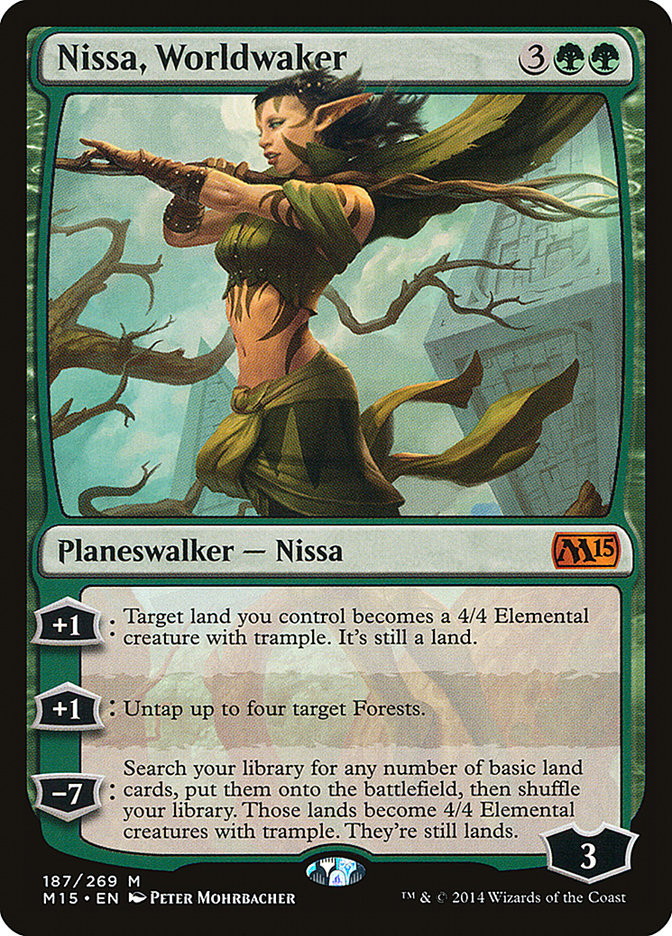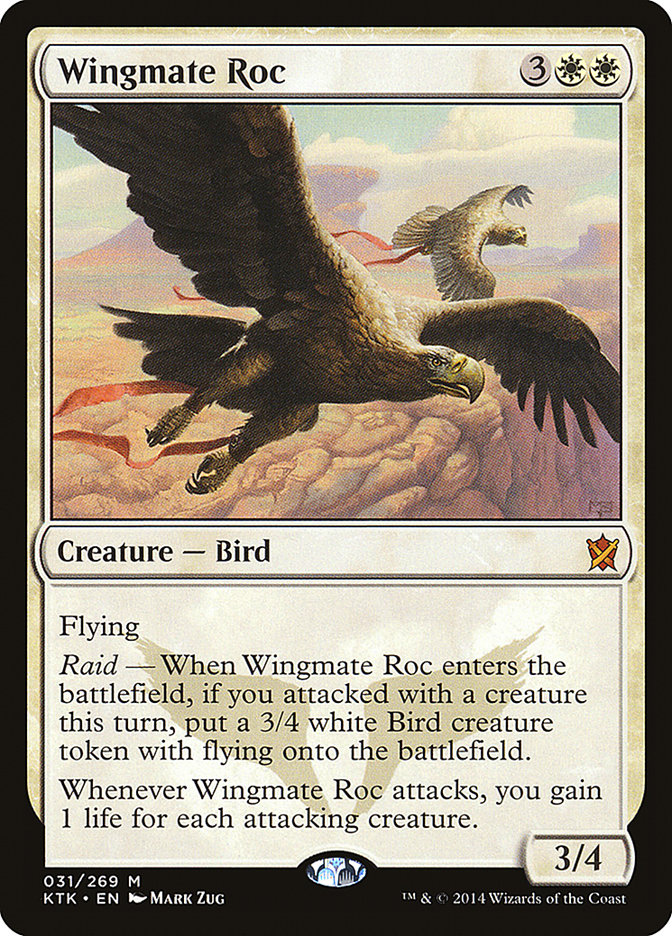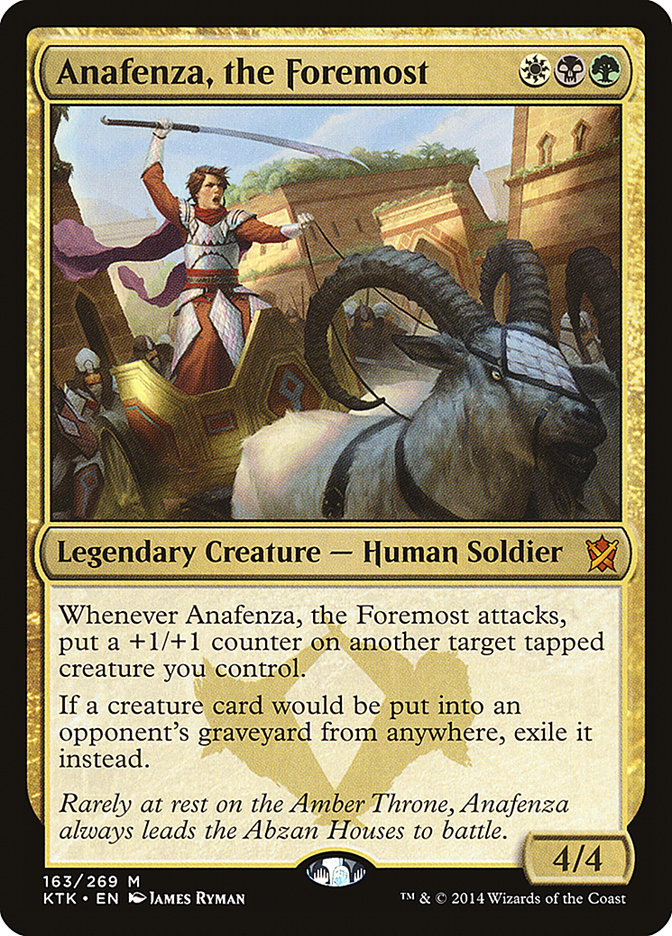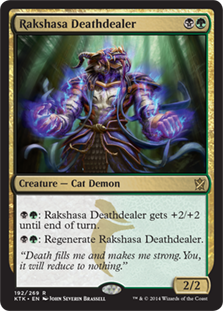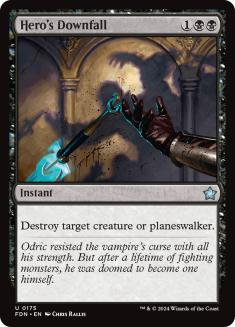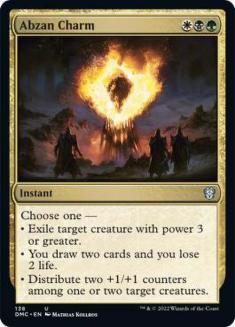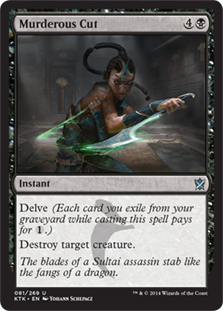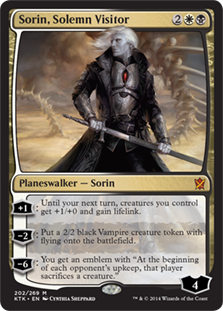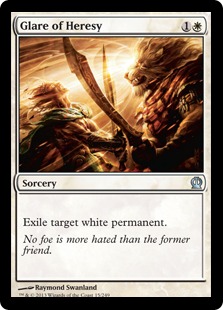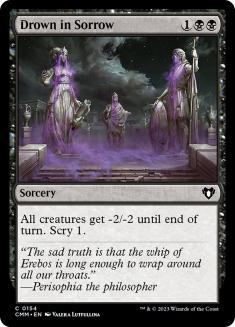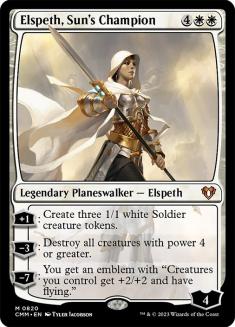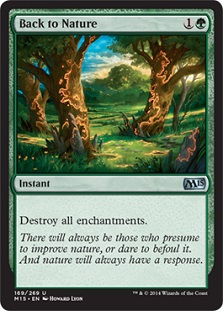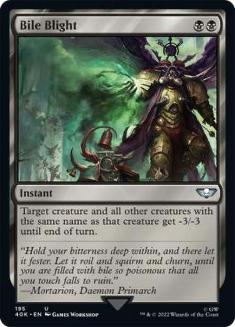People lead all kinds of different lives. Some people work a normal 9-to-5 job and then come home to their family afterwards. Some people are a desk clerk
by day and a superhero by night. Some live the Thug Life. For others, it’s the Hug Life. The last two weeks have caused me to really take an introspective
look at myself. What life do I lead? After emerging from what seemed like eons of solitude and self-contemplation, I have come to just one singular
conclusion.
I’m leading the Rhino Life.
Now, that doesn’t mean I am actually a Rhinoceros. I don’t typically charge people at a frighteningly fast speed, although I wouldn’t rule it out. It just
means I really love casting Siege Rhinoceros. A lot. And if you find yourself sharing in this same centuries-old pastime, then perhaps this article is your
kind of jam. Strawberry has nothing on Rhino.
Lately, I’ve been hooked on a different kind of Rhino phonics. It’s not the typical Abzan Midrange or Abzan Reanimator decks that have been such a driving
force in Standard. Instead it’s the oft-maligned Abzan Aggro archetype. I played the deck in the SCG Players’ Championship, where I finished fourth. I also
played it last weekend in a PTQ, where I lost in the finals. Both times, I felt like I had the best deck in the room, and I’d like to share what I have
learned about the deck and where I think it should progress moving forward.
To start with, here is the most recent list I played at the PTQ last weekend.
Creatures (20)
Lands (25)
Spells (15)

The only change I made to my Players’ Championship list was to cut two copies of Nissa, Worldwaker from the sideboard to make room for Elspeth, Sun’s
Champion. It wasn’t a very big change, and ultimately, it was a pretty lazy change. There are a few reasons for this. One is that the list is actually very
well-built. The list that Andrew Tenjum and Thea Steele played to 9th and 10th place at the Standard Open in Seattle a few weeks ago was very well-suited
to the current metagame. It was a great deck, and you don’t really need to alter greatness very much.
Also, it was Christmas, and I wanted to spend a week with my family and friends and not with Magic. I didn’t play any games over the holidays, outside of
the PTQ itself, and didn’t really bother to think a whole lot about Magic. While this game is great, and in fact my livelihood, it is still worth putting
it in perspective. Family, friends, and people are still a lot more important than going 3-1 in another Magic Online Daily Event. It took me years to learn
that lesson, and I still have a lot to learn there, but I’m really glad I did.
As to why I’ve chosen Elspeth over poor Nissa, the reason is two-fold. For one, Elspeth is simply a more powerful threat than Nissa in other grindy,
midrange matchups. Nissa isn’t particularly powerful there. 4/4s don’t attack through Siege Rhino, and she is vulnerable to just being killed by whatever
creatures your opponent has the turn you play her. As a result, Elspeth is a more versatile card.
Also, Elspeth also just fits the strategy better. She can play as removal or a threat, a distinction that is very important. Also Elspeth and Nissa are
both effectively six-mana planeswalkers. Paying five for Nissa and making a tapped 4/4 isn’t often the worst, but it also takes a while for that play to
really affect the board. It’s best to play Nissa with six mana so you can make a 4/4 and be able to also attack or block with it on the same turn. If
that’s the case, in a deck without the ability to ramp, I’d rather play a card that remains very powerful no matter how late into the game it is. This deck
is also very mana hungry, and Nissa competes with cards like Wingmate Roc and Rakshasa Deathdealer. If you’re attacking with your lands, you’re not also
casting any new expensive cards that you draw. Elspeth, on the other hand, complements Wingmate Roc quite well.
Sideboard planeswalker discussion aside, what makes the deck tick?
The Crunchy Critters
This deck utilizes twenty of the sweetest and hardest hitting creatures in the game. It’s what I call a natural twenty. All of these creatures are both
powerful threats on their own accord, and also play well with each other.
Wingmate Roc is the top end for the deck. This is the card that really makes Abzan Aggro a viable archetype in Standard. I’ve seen posts and ideas
suggesting trimming or cutting Wingmate Roc from the deck, and I couldn’t disagree more. Yes, sometimes you can’t raid it, but if you were to calculate the
percentages for “What card do I most often want to topdeck while playing with the deck?” Wingmate Roc is the clear winner.
This is how you beat other midrange decks. Decks like Abzan Midrange and Abzan/Sultai Reanimator have a natural advantage over this style of deck. They are
playing a similar game plan, but slightly slower, with cards that go over the top and trump yours. All throughout Magic, we see these kinds of matchups
taking place, where going “slightly bigger” is the best way to beat similar decks.
Wingmate Roc reverses that. Because very little goes bigger than Wingmate Roc, and it’s a card that these aggro decks can play, but the more controlling
Abzan decks cannot. Wingmate Roc is a giant middle finger to Courser of Kruphix decks everywhere. They might be eeking out small advantages here and there,
but you can just say “I don’t really care. I’m just going to put a lot of really huge flying creatures in play and see how that works out.”
Hint: it works out really well.
The rest of the creature base is really designed to accommodate Wingmate Roc. Cards like Fleecemane Lion and Rakshasa Deathdealer are very good at swinging
in to trigger raid for Wingmate. Those cards put a lot of pressure on your opponent. They can either block the creature, in which case you can pump or go
monstrous to kill their blocker, or they can take the damage, and risk having Wingmate Roc come crashing down to smush their hopes and dreams. It’s like a
game of Prisoner’s Dilemma where every play results in the worst option.
These cards are also great in that they scale well. They are good threats on turn 2 and just as good of threats on turn 5 or turn 8. It’s important in a
deck like this that can’t always win a game quickly to have threats that are still going to impact the game later on.
To round things out we have Siege Rhino and Anafenza, the Foremost. While this article is about leading the Rhino Life, I don’t think I need to talk that
much about Siege Rhino. It’s one of the most efficient creatures we have ever seen and it is already become a dominant force in Modern. Siege Rhino holds
this deck together. It’s a defensive and offensive threat that simply can’t be contained. Siege Rhino is the Lebron James of Standard.
Anafenza, the Foremost, unlike Fleecemane Lion and Rakshasa Deathdealer, doesn’t actually scale very well. Also, by virtue of being legendary, she doesn’t
scale well in multiples either.
However, Anafenza is still a very integral part of the deck. An unchecked Anafenza makes life miserable for the Whip decks. It basically demands an
immediate removal spell or it completely obliterates their ability to go over the top of you with Whip. It invalidates cards like Sidisi, Brood Tyrant,
Pharika, God of Affliction, and Whip itself.
Anafenza also provides the ability for nut draws, something that is an important feature for a lot of the best Standard decks. Curving Fleecemane Lion into
Anafenza is exactly twenty damage by turn 5. It’s actually very easy to just tempo out and kill an opponent with that curve backed up by a few removal
spells if they lack any removal of their own.
Playing four copies of Anafenza helps ensure that you can play it early in the game to promote nut draws and provide a powerful threat against Whip decks.
Anafenza also tends to die a lot. She can get out of hand quickly and demands an immediate response, meaning have extra copies are rarely dead.
The Support
Thoughtseize doesn’t really do anything special for the deck. You’re not protecting a combo or trying to break one up. It’s just a powerful card that can
disrupt synergy and give you a road map for how to play out the game. It’s important to note that Thoughtseize isn’t actually an important card though. If
you have the option between playing a land that enters the battlefield tapped in order to facilitate smoother turns in the future or cast a Thoughtseize,
it is usually right to play the tapped land. Thoughtseize can wait. Curving out is more important.
Bile Blight is a removal spell that simply fills holes the deck has. It’s not the best removal spell or the most powerful in Standard, but what it does do
is address cards that are actually good against this deck. The two cards I’m talking about are Hordeling Outburst and Hornet Queen. They are basically two
extremes of the format, and Bile Blight is a clean answer to both. Both also happen to be huge issues for the deck, so it is important to be able to deal
with them.
Bile Blight is also serviceable as a Neck Snap. The creatures in this deck are so big and hit so hard that your opponent has to pretty much block them when
they have a chance. They might tap out for a Doomwake Giant and then block your Fleecemane Lion when you attack. You can save your Lion and kill the Giant
with a little mid-combat William Blight action.
Hero’s Downfall and Abzan Charm are interesting. Charm is a more powerful card, but I’ve opted for a 3/3 split because Downfall is easier to cast, deals
you less damage from lands most of the time, and is needed in matchups where trying to run you down with planeswalkers is the opposing plan, such as with
Abzan Midrange or Sultai Reanimator post-sideboard.
A miser’s Murderous Cut is just good, clean living.
The Weakness
Abzan Aggro does come with a few weaknesses. It can sometimes struggle with decks that are able to quickly apply pressure. Between Thoughtseize, Abzan
Charm, and an extremely painland and fetchland centric manabase, the deck deals an enormous amount of damage to itself. Some decks, like Jeskai Tokens or
W/U Heroic, can often capitalize on that by just being fast enough or having enough reach to make all of those little stings come back to bite.
Tied in with the above, sometimes the manabase can be a giant issue. Trying to cast both Fleecemane Lion and Bile Blight in the same deck is a pretty
greedy venture. Oftentimes, you have to mulligan otherwise serviceable hands because there is no way to cast all of your spells without just killing
yourself. Sometimes you have to keep risky hands that lack a certain color of mana and just hope to get there.
The Gameplay
Abzan Aggro is at its core an aggressive strategy. It even says so in the name, and everything you read on the internet is true, therefore, logic dictates
that it is. As a result, it’s important to prioritize being able to curve out and apply pressure. I generally prefer playing one of my own threats over
killing an opposing threat.
With that being said, the deck has a lot of staying power. Unlike a deck like Boss Sligh, this deck is capable of winning a game that goes to turn 15
against other midrange or control decks. There’s no need to overextend or open yourself up to blowouts just to try to be a little faster.
One of the most important skills when playing this deck is to balance all of the working pieces of the deck. You have to juggle ten enters-the-battlefield
tapped lands, a desire to curve out from turns 2 to 5 with creatures, and play the other support spells in a way that advances your game plan. It’s really
important to really consider how you intend on winning the game and play to it.
For example, if you have two Sandsteppe Citadels and a Forest in your hand along with a Fleecemane Lion and Anafenza, how do you sequence your turns? The
answer is that “it depends.” If you’re playing against Sultai Reanimator and you’re afraid that they have something like Sidisi, then playing the second
Sandsteppe Citadel on turn 2 to facilitate Anafenza is probably correct. Most of the time though, I would just play the Lion on turn 2 and hope to draw an
untapped land. This can also be altered by draw steps. If I draw Thoughtseize on turn 2, then I’m just going to play that along with the other Sandsteppe
Citadel. That way I still get to make a play and also set up future turns. However, if I draw a second two-drop, I’m probably just going to cast the
Fleecemane Lion by playing the Forest. That lets me set up a game where I can play the second Lion the next turn and then Anafenza the following.
It’s really important to also sequence your removal spells in a way that makes sense. For example, if your opponent casts a Sidisi, and your hand is Bile
Blight, Hero’s Downfall, and Abzan Charm, which do you use to kill it? Again, the answer is “it depends.” Bile Blight is the worst spell here, and
therefore, the most attractive option. However, if the opponent has a Hornet Queen, it would be a huge mistake to blow the Bile Blight at this juncture.
You have to judge, based on how the game has played out, whether it is worth playing around Hornet Queen or not.
Let’s say you want to play around Hornet Queen and choose to save the Bile Blight. Even then, there are still pros and cons to which removal spell to use.
Abzan Charm exiles, playing around Whip, but Abzan Charm is also a more powerful spell that could be valuable for drawing cards or making big creatures
later. Hero’s Downfall is a worse card than Charm, and thus, it’s tempting to want to blow this first, but what if your opponent’s next play is a Courser
of Kruphix, which Charm can’t kill? Maybe your creatures are bigger than Courser, so you don’t care. Maybe you don’t have any pressure yet, and Courser is
the scariest card your opponent could play.
Being able to make the right plays in these situations is what defines being successful or not with Abzan Aggro. Sometimes they don’t matter, but usually
they do. The key is to know your opponent’s deck, know the cards you are afraid of, and play to minimize the impact of those cards. It is a balancing act,
but mastering how to sequence is an important skill for this deck and when playing Magic as a whole; it will lead to better results.
Sideboarding
Ahh, yes. The part of the article that everyone has probably skipped to. Sideboarding is the single most important skill in Standard right now. The thing
that separates players like Brad Nelson from the average joes when it comes to Standard is that Brad has fluid, cohesive sideboard plans and knows how and
why they matter. Almost every deck in Standard has the ability to shift gears in post-sideboard games, and it’s important to know when that matters, why it
matters, and how you should do it. It’s also important to know when your opponent is going to be doing that and how to sideboard against their sideboard.
I could write an entire article just on sideboarding in the Sultai Reanimator matchup alone, so these are going to be trimmed down explanations from what
they could be, but hopefully they help anyway.
One mistake that a lot of players make is to just blindly follow a sideboarding guide. Standard right now is so skill intensive that this kind of blind
adherence to a sheet of paper is actually just a death sentence. Sideboarding guides are exactly that, a guide. They are not a hard and fast rule, and
being inflexible and unable to adjust to what your opponent is doing means that players who are able to change gears and tactics against you will always
have an advantage. Don’t give your opponents an advantage! The most important thing you can do to succeed in Standard right now is to learn the
ins-and-outs of your deck and why you are sideboarding a specific way in a specific matchup, and have the experience and presence to understand when it
won’t work and when to change that.
With that being said, here are some suggestions in matchups.
VS Jeskai Tokens
Out:
In:
This has been the most effective plan against them in my experience. However, this plan is based on the idea that they don’t have Mantis Rider and that
they are leaving Seeker of the Way in their deck against you. If they don’t have Rider or Seeker in against you, then Glare becomes worse. If they have
Mantis Rider, then Murderous Cut and Hero’s Downfall become better.
The idea against them is to turn into an Abzan Midrange deck post-board. Play eight token wrath effects, removal spells for Jeskai Ascendancy itself, and a
threat in Siege Rhino that they struggle to overcome. Sorin allows you to win race situations, which a surprisingly high number of games devolve into.
Treasure Cruise is a great card, but it doesn’t matter if they draw three cards that can’t outclass a Rhino.
VS W/U Heroic
In:
Those are the cards you want. What you want to take out depends on whether you’re on the play or draw. For example, Anafenza on the draw isn’t particularly
impressive against them. Fleecemane Lion and Deathdealer come down earlier and are actually impressive threats lategame as a monstrous Lion or regenerating
Deathdealer can match up against even the biggest heroes. Anafenza is only really good exactly on turn 3 and only really so on the play because you can
actually race them then. Extra copies of Anafenza are also pretty useless because creatures almost never trade in combat, and they don’t play any way to
remove her.
Bile Blight is a card I have a mixed opinion on. It’s great on turn 2 to kill a creature before they have a chance to protect it and pump it. It’s mediocre
later because their creatures grow too big to handle with Billy Blight.
It’s important to kill their creatures when they are tapped out so they can’t protect them. Trying to kill creatures midcombat just invites them to blow
you out with cards like Gods Willing and Ajani’s Presence. Thoughtseize is also a powerful tool to strip protection spells to clear the way for removal
spells or strip creatures and pump spells and just leave them with only protection spells, which aren’t enough to punch through Abzan Aggro’s bigger
creatures.
VS Abzan/Sultai Reanimator
These are the absolute hardest matchups to sideboard for. It’s really hard to know what your opponent is going to do, because they might leave in the full
Whip package, go halfsies on the Whip package, or just cut it altogether. In some of those situations, Back to Nature is the best card in your deck. In
others, it is dead or close to it.
Generally speaking, you definitely want:
In:
And you definitely don’t want:
Out:
Thoughtseize isn’t that effective against these decks because so many of their cards all do the same thing. It doesn’t really matter if you take Utter End,
Hero’s Downfall, or Murderous Cut. Your creature is dead either way.
If they leave in Courser, Eidolons, and Whips, then you want:
In:
If not, you want zero or one. I usually hedge by boarding in one or two copies at first and upping to three if I see they are still gung-ho on enchantments
or siding those out if I see the opposite. I also am going to adjust based on whether they have seen the card. If I savagely blow them out with Back to
Nature in game 2, and they go back to the well to sideboard again afterward, then I’m probably just going to casually slide those out.
Against Abzan Reanimator, you want to cut almost all of your Bile Blights, leaving in one or two copies for Hornet Queen. The card doesn’t have a high
impact since it can’t kill Siege Rhino, their biggest threat.
Against Sultai Reanimator, Bile Blight is a more powerful card because it can handle Sidisi, as well as Hornet Queen, so it maintains its value over the
course of the game. Here I would want 2-3 copies in my deck against them post-board.
Against Abzan Reanimator, Hero’s Downfall is typically worse than Abzan Charm. Charm exiles the creature and has more useful modes. It can also draw cards
if the game gets grindy.
However, against Sultai Reanimator, Hero’s Downfall is significantly better. They frequently side into Kiora, the Crashing Wave and Ashiok, Nightmare
Weaver against you, which means it is important to have access to Hero’s Downfall if you don’t have the kind of pressure that can slay either of these two
planeswalkers before they planeswalk away with the game.
For that reason, I will often do something like board into two Murderous Cuts against Abzan Reanimator and cut Downfall, but board out Murderous Cut
against Sultai Reanimator and keep all of my Downfalls.
Sometimes Abzan Reanimator plays things like Banishing Light, Anafenza, Soul of Theros, and other white cards to go with their Siege Rhinos. In situations
like that, there’s no shame in boarding in a Glare of Heresy or two to keep them honest. I have indeed Glared a Soul of Theros before, and it feels as good
as it sounds.
VS Abzan Midrange
Out
In:
I cut one Anafenza because you can’t afford to have dead cards in this matchup, and it sometimes sticks around in play if they have a Siege Rhino to keep
it from attacking, which can strand other copies in hand. Bile Blight is pretty poor since all of their threats are planeswalkers or have four or more
toughness, and Murderous Cut isn’t a good card since their way to win is to grind you out with card advantage and planeswalkers.
Glare of Heresy hits Elspeth, Ajani, and Siege Rhino, meaning it is versatile enough to want, but it also doesn’t hit things like Courser of Kruphix, and
is a reactive card, meaning it’s not something we want to overindulge in. The planeswalkers are great as extra threats that can pressure them in unique
ways.
I keep in Thoughtseize for this matchup. They are better at winning a longer game than you are. Disrupting them a bit can help keep them off balance long
enough for you to establish a boardstate they can’t overcome. I’ve heard that this is the worst matchup for Abzan Aggro, but I think it’s very close, and
with four copies of Wingmate Roc to blow them out, I think Abzan Aggro might even be favored.
VS Abzan Aggro
The ol’ college mirror match. I played a mirror match during the swiss at the PTQ last weekend and after the match I discussed how I sideboarded with my
opponent. That opponent then went on to make top 8, top 4, and was almost my finals opponent. I was really getting scared that I would lose to my own
sideboarding strategy in the finals! Thankfully, I instead just lost to a different deck instead!
Whew. That could have been bad.
I also played two more mirror matches in the top 8 and top 4. Indeed, Abzan Aggro was a full 50% of the PTQ top 8. Deck is good.
Out:
In:
The most important card in the mirror match is Wingmate Roc. I play every game with one singular thought in mind: “How can I stop them from raiding
Wingmate Roc and how can I raid my own?” That runs through my mind the entire game, and winning Roc fights is almost entirely the key to winning the
mirror.
Cards like Sorin and Elspeth are extremely hit or miss. Sometimes they do good things, other times they rot in hand or are just actively bad. I’m not in
love with them in this matchup, but I do like them better than Bile Blight, since Blight also kills your own creatures when both players have something
like a Fleecemane Lion in play.
I sometimes keep in a couple of Bile Blights on the draw just to regain initiative.
VS U/W Control
Out:
In:
Hero’s Downfall only kills Elspeth, and Glare of Heresy does a better job of that while also being able to blow up Banishing Light or Brimaz. A single Back
to Nature is nice for occasional Banishing Light blowouts or in case they have something like Nyx-Fleece Ram for some reason.
VS U/B Control
In:
Out:
You have to leave in dead or semi-dead cards like Hero’s Downfall and Murderous Cut. It sucks, but so does U/B Control! The deck isn’t particularly
powerful, not a matchup I expect to play against a lot, and I feel confident beating it even if I have to keep some duds in the process.
VS Mardon’t
This is another fluid matchup like the Whip decks where they could swap to an Anger of the Gods/Read the Bones/End Hostilities strategy against you or they
could be trying to Rabblemaster, Seeker of the Way, and Hordeling Outburst you.
Elspeth is good, regardless. Glare of Heresy is usually good in some capacity, because at worst it deals with Butcher of the Horde, Seeker of the Way, and
Chained to the Rocks. Sorin should probably come in, but isn’t a huge game changer. Crackling Doom is a neat and complete answer to Sorin, killing the
vampire and the Sorin, making his value worse.
I don’t actually have anything concrete to give you in terms of “bring in, side out.” I often side out Murderous Cut or Abzan Charm. Cut can’t kill
Sarkhan, the Dragonspeaker, and Abzan Charm can’t kill Seeker of the Way or Goblin Rabblemaster except in specific scenarios.
I typically cut one Anafenza, since I don’t want to get stuck with extra creatures in hand.
Bile Blight is either really good or really bad against them, depending on how they sideboard. I typically trim down to two copies to hedge and might up or
down the number depending on whether I think they are going to go with Anger of the Gods or cheap creatures.
Thoughtseize can probably get the axe regardless, since it’s a midrange matchup that will probably go long, yet they can’t really go over the top of you.
One way to lose is to draw too many late Thoughtseizes, and an easy way to win is Wingmate Roc.
Bonus
I’m working on a list that cuts Thoughtseize from the maindeck to have access to planeswalkers. This list is basically pre-sideboarded against a lot of
midrange decks. I upped to 26 land to facilitate it.
Creatures (20)
Planeswalkers (4)
Lands (26)
Spells (10)
Sideboard

I haven’t tested much with this list, but I think it is another way to go with the deck that could end up being pretty good. I intend on playing more with
it because I think it may end up just being a huge upgrade on the standard list.
Oh, and one last thing.
Don’t side out Siege Rhinoceros. That goes against the Rhino Life. I know that I personally am R4L. Rhino4Lyfe. Are you?


